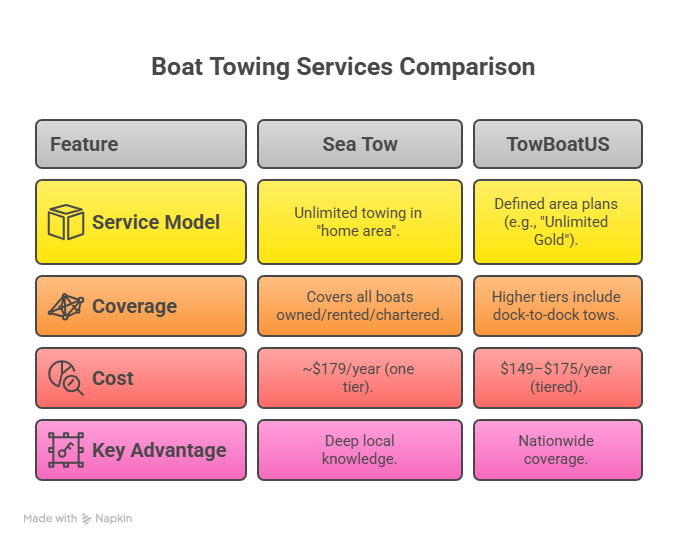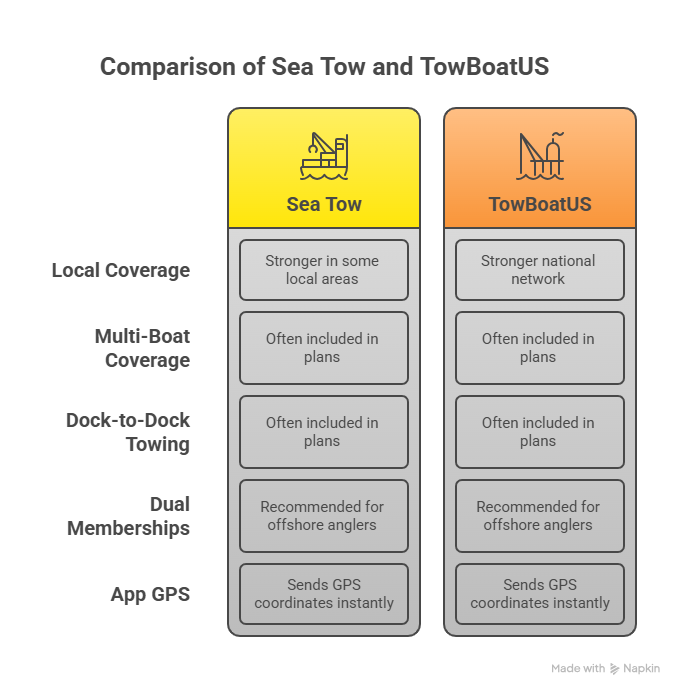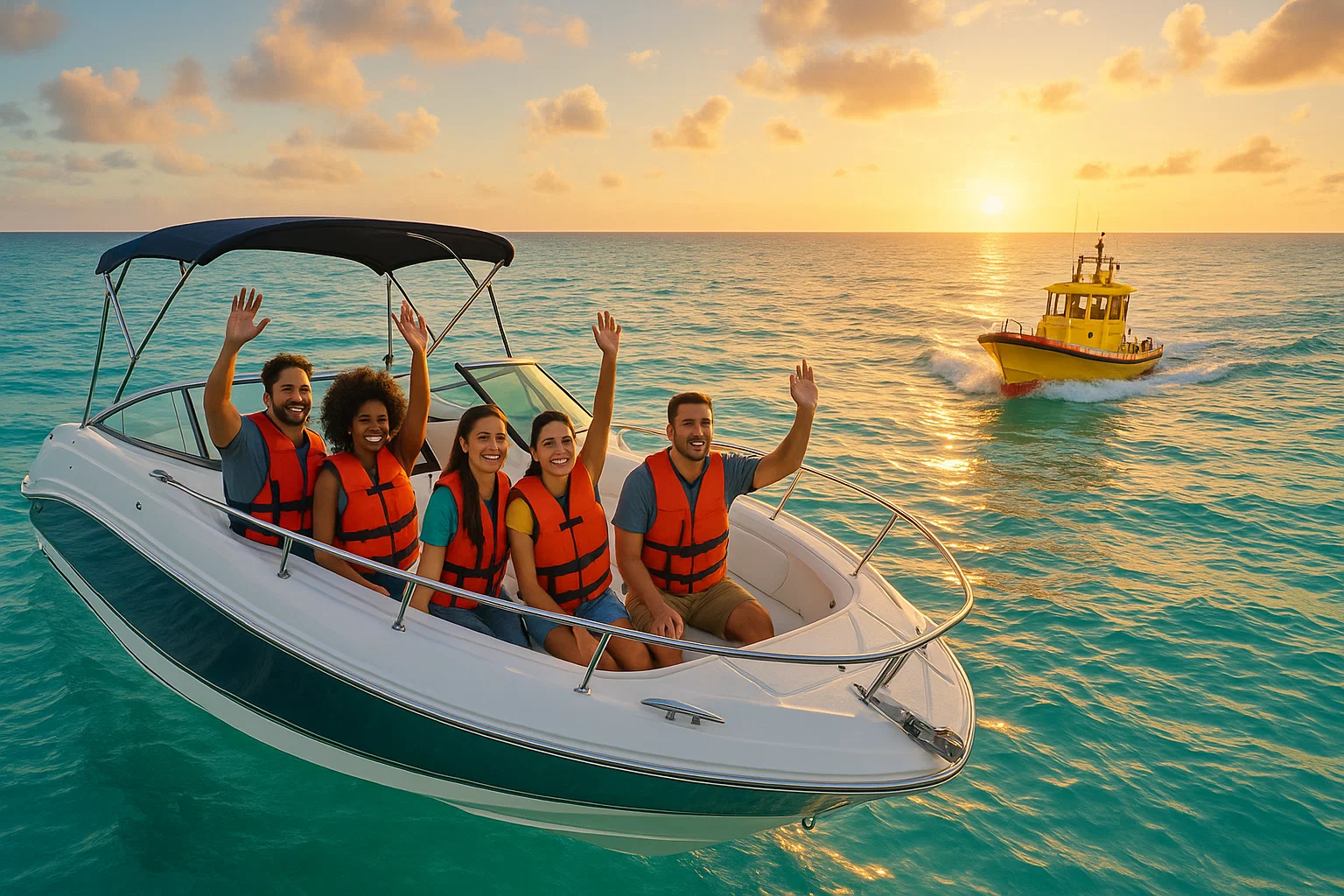Boat Towing Near Me: 15 Years of Rescues, Lessons, and Saving Boaters’ Wallets
I’ve been a marine towing captain in South Florida for 15 years, pulling boats off sandbars and delivering fuel from Key Biscayne to Fort Lauderdale. Last July, a guy named Carlos called me in a panic—his Sea Ray 230 stalled off Miami Beach, leaving him drifting with his kids on board. I got there in 20 minutes using Sea Tow’s app, towed him back for free under his $179 membership, saving him a $900 bill. Searching for “boat towing near me”? Here’s my no-nonsense guide to staying safe, saving money, and picking the right towing service, packed with what I’ve learned from hundreds of rescues.
Table of Contents
What’s Boat Towing and Why Do You Need It?
Boat towing services are your lifeline when things go south on the water. Think of them as roadside assistance for your boat—ready 24/7 to handle breakdowns, groundings, or dead batteries. I’ve towed over 300 boats, from center consoles to yachts, and trust me, nobody plans to get stranded.
These services cover way more than just towing. They’re a safety net for common issues like fuel delivery, jump-starts, or pulling you off a soft sandbar. Without a membership, a single tow can hit $700–$1,000, but a $150–$180 annual plan covers unlimited calls. It’s a no-brainer for anyone who boats regularly.
Why Do Boats Need Towing Anyway?
Boats break down for all sorts of reasons, and South Florida’s heat and saltwater make it worse. I’ve seen it all—engines quitting, props tangled in nets, batteries drained from a forgotten fishfinder. Here are the top culprits I deal with:
- Mechanical Failures: Engines, steering, or electrical systems crap out. Last summer, Maria’s Yamaha 200 died mid-trip off Stiltsville—bad fuel pump, $800 tow avoided with her membership.
- Running Aground: Sandbars shift in Miami’s bays. I pulled a Grady-White 208 off a mudflat at Dinner Key last month—took 15 minutes with the right gear.
- Fuel Issues: Bad fuel or empty tanks are common. I delivered 5 gallons to a stranded Bayliner in Key Biscayne in June 2024—$200 saved.
- Dead Batteries: Leaving electronics on kills power. A quick jump-start got a client’s Boston Whaler running without a tow.
These issues hit even seasoned captains. A towing membership turns a bad day into a quick fix.
What’s the Difference Between a Tow and a Salvage?
This is the million-dollar question—literally. A tow is routine help for non-emergency issues, like a dead engine or soft grounding, covered by your membership. A salvage is an emergency rescue when your boat’s in “marine peril”—sinking, on fire, or hard aground on rocks. Salvage costs aren’t hourly; they’re a percentage of your boat’s value, sometimes $10,000+.
Last August, a client in Fort Lauderdale thought his sinking center console was a simple tow. I asked, “Is this under my membership or a salvage?” He clarified with the captain, called his insurer, and saved thousands. Always ask this question before a tow line’s attached—it’s your wallet’s best defense.
How Much Does Boat Towing Near Me Cost?
Without a membership, a tow is a gut punch. Non-members pay $250–$500 per hour, with most jobs hitting $700–$1,000. That covers the towboat’s fuel, insurance, and my license as a captain. I towed a non-member’s Sea Ray 350 from Biscayne Bay to a marina last year—$900 bill, and he was kicking himself for not joining Sea Tow.
A membership, like Sea Tow’s $179 or TowBoatUS’s $149–$175, covers unlimited tows, fuel delivery, and jump-starts. One call pays for the plan. Members also get priority over non-members, especially on busy weekends like the Fourth of July.
Are Insurance Towing Add-Ons Any Good?
Some boat insurance policies offer towing coverage, but it’s a weak substitute. They’re reimbursement-based—you pay upfront, then fight for a claim. Caps are low, often $250–$500, leaving you stuck with the rest of a $1,000 bill. I saw a guy in Coconut Grove last spring pay $800 out-of-pocket because his insurance capped at $300.
Memberships give direct, priority service with no upfront cost or paperwork. If you boat more than a few times a year, skip the insurance add-on and get a dedicated plan.

Sea Tow vs. TowBoatUS: Which Is Better for Boat Towing Near Me?
Choosing between Sea Tow’s yellow boats and TowBoatUS’s red ones depends on where you boat and what you need. I’ve worked with both, and here’s how they stack up from my experience.
Sea Tow: Local Experts
Sea Tow runs franchises, so your local captain knows your waters like the back of their hand. In Miami’s tricky channels, that’s gold. I pulled a client’s Pursuit 265 off a sandbar near Key Biscayne in 2024—knew exactly where the tides shift.
- Service Model: Unlimited towing in a “home area” with no dollar or distance limits.
- Coverage: One membership covers all boats you own, rent, or charter.
- Cost: ~$179/year, one tier.
- Perk: Deep local knowledge, great for coastal boaters.
TowBoatUS: Nationwide Reach
TowBoatUS, part of BoatUS, has a huge network, perfect for boaters who travel. Their tiered plans fit everyone from lake anglers to offshore cruisers.
- Service Model: Plans like “Unlimited Gold” or “Unlimited Freshwater” with defined areas.
- Coverage: Higher tiers include dock-to-dock tows for repairs.
- Cost: $149–$175/year, depending on tier.
- Perk: Nationwide coverage, ideal for trailered boats.
My Comparison Table
I put this together from tows I’ve done in South Florida:
| Provider | Coverage Area | Cost | Key Features |
|---|---|---|---|
| Sea Tow | Local “home area” | $179/year | Unlimited towing, all boats covered |
| TowBoatUS | Nationwide network | $149–$175/year | Tiered plans, dock-to-dock tows |
My Take: If you stick to Miami or Fort Lauderdale, Sea Tow’s local expertise wins. If you cruise or trailer to new waters, TowBoatUS’s network is better. Check their coverage maps for your area—local presence is everything.
How Do I Choose the Right Boat Towing Service Near Me?
Picking the best service isn’t about the cheapest price—it’s about matching coverage to your boating life. Here’s my three-step process from years of seeing what works:
- Check Local Coverage: Pull up Sea Tow and TowBoatUS’s coverage maps. I helped a client at Bahia Mar last summer pick Sea Tow because they had three boats in his bay, versus TowBoatUS’s one. If you boat far from home, lean toward TowBoatUS’s national network.
- Read the Fine Print: Look for multi-boat coverage or dock-to-dock tows. I once towed a friend’s rented Cobalt 220 for free under his Sea Tow plan—saved him $600. Confirm what’s included.
- Consider Dual Memberships: For offshore anglers or cruisers, I recommend both Sea Tow and TowBoatUS. It’s $300–$350/year but guarantees the fastest response, especially post-storm. I saw this save a guy’s trip during a busy Memorial Day weekend.
How Do I Call for Boat Towing Near Me?
When you’re stranded, staying calm and prepared gets you help faster. I’ve responded to hundreds of calls—here’s what works:
- Prioritize Safety: Ensure everyone has a life jacket and drop anchor if safe to avoid drifting into a channel. Turn on your anchor light at night.
- Use the App: Sea Tow and TowBoatUS apps send your GPS coordinates instantly. I got to Carlos’s Sea Ray in 20 minutes because his app pinged his exact spot off Miami Beach.
- Provide Details: Share your membership number, GPS coordinates, boat description (e.g., “24-foot Sea Ray, white”), problem (“engine won’t start”), and number of people on board.
- Prep for the Tow: Clear your bow and have dock lines ready. Follow the captain’s instructions—I’ve seen boaters mess up tows by ignoring simple directions.

Why Do Towing Memberships Save Money?
A single tow can cost $700–$1,000, but memberships cap your cost at $150–$180/year. I towed a non-member’s Boston Whaler from Key Biscayne to a marina last year—$850 bill. He joined TowBoatUS the next day. Members also get priority, which matters on crowded holiday weekends.
What’s Covered Under a Boat Towing Membership?
Memberships cover towing to a marina, fuel delivery, jump-starts, soft ungroundings, and disentanglements. Last June, I delivered fuel to a stranded yacht off Fort Lauderdale—free with their Sea Tow plan. Always check your plan’s limits, but most cover any boat you’re on.
Can I Use Boat Towing Services Without a Membership?
Yes, but it’s pricey—$250–$500/hour. Non-members wait longer, too. I helped a non-member at Stiltsville last spring; his $900 bill convinced him to join Sea Tow. If you boat often, the membership pays for itself after one call.
How Fast Is Boat Towing Near Me?
Response times depend on your location and the provider’s presence. In Miami, I’ve gotten to boats in 15–30 minutes using the app’s GPS. Busy weekends or remote areas like the Everglades can take longer—up to an hour. Dual memberships help here.
What Should I Ask Before a Tow?
Always ask, “Is this under my membership or a salvage operation?” I’ve seen boaters save thousands by clarifying this upfront. If it’s salvage, call your insurer immediately. A buddy of mine avoided a $12,000 bill this way in 2024.
FAQ: Common Questions About Boat Towing Near Me
What does “boat towing near me” cover?
Memberships cover towing, fuel delivery, jump-starts, soft ungroundings, and disentanglements. I pulled a client’s Bayliner off a sandbar in Key Biscayne last month—free with his $179 Sea Tow plan. Check coverage maps at seatow.com or towboatus.com.
How much is a tow without a membership?
Non-members pay $250–$500/hour, averaging $700–$1,000. I towed a non-member’s yacht in 2024—$900 bill. Join Sea Tow or TowBoatUS for $150–$180/year to avoid this.
How do I find boat towing near me?
Use Sea Tow or TowBoatUS’s apps for instant GPS-based dispatch. I got to a stranded boat off Miami Beach in 20 minutes last July using the app. Save their dispatch numbers as backups.
Is Sea Tow or TowBoatUS better for my area?
Check their coverage maps. Sea Tow’s great for local waters like Miami; TowBoatUS suits travelers with its nationwide network. I helped a client pick Sea Tow for Fort Lauderdale’s tricky channels.
What’s the difference between tow and salvage?
Tows are routine (e.g., dead engine), covered by memberships. Salvage is for emergencies (e.g., sinking), costing a percentage of your boat’s value. Ask, “Is this a salvage?” to avoid a $10,000+ bill.
Can insurance replace a towing membership?
Insurance towing add-ons have low caps ($250–$500) and require upfront payment. I saw a guy pay $800 out-of-pocket in 2024 due to a cap. Memberships offer direct, unlimited service.
How fast is boat towing response time?
In busy areas like Miami, expect 15–30 minutes with the app. Remote spots or holidays can take an hour. I cut response time for a client in 2024 by using both Sea Tow and TowBoatUS memberships.
Conclusion: Your Ticket to Worry-Free Boating
Boating’s about freedom, not stressing over a dead engine or a sandbar. A towing membership—Sea Tow or TowBoatUS—gives you peace of mind for $150–$180 a year. I’ve seen memberships save boaters thousands, like Carlos’s $900 tow last July. Check coverage maps at seatow.com or towboatus.com, save the dispatch number, and ask, “Is this a salvage?” before any tow. That’s how you keep your focus on the water, not the worry.
Author Bio
I’m Alex, a marine towing captain with 15 years of experience in South Florida, from Miami to Fort Lauderdale. I’ve towed over 300 boats and hold a USCG Master License. My work with Sea Tow and TowBoatUS has taught me what keeps boaters safe and wallets intact. Follow me on LinkedIn: linkedin.com/in/alex-marine-tow. Contact: [email protected].


Leave a Reply